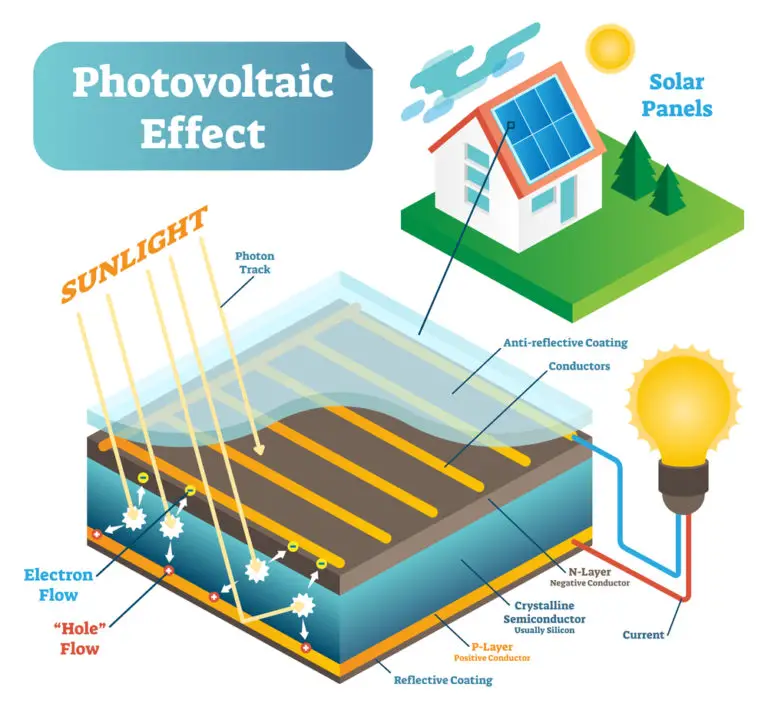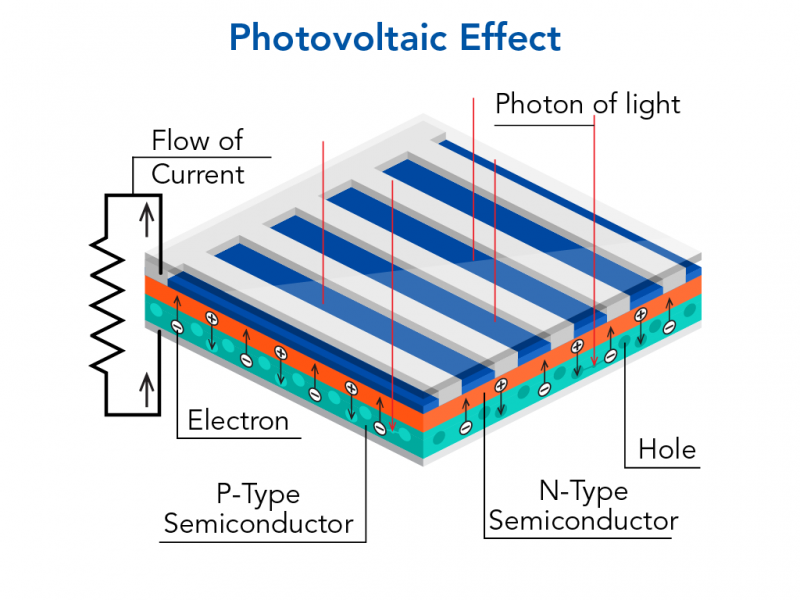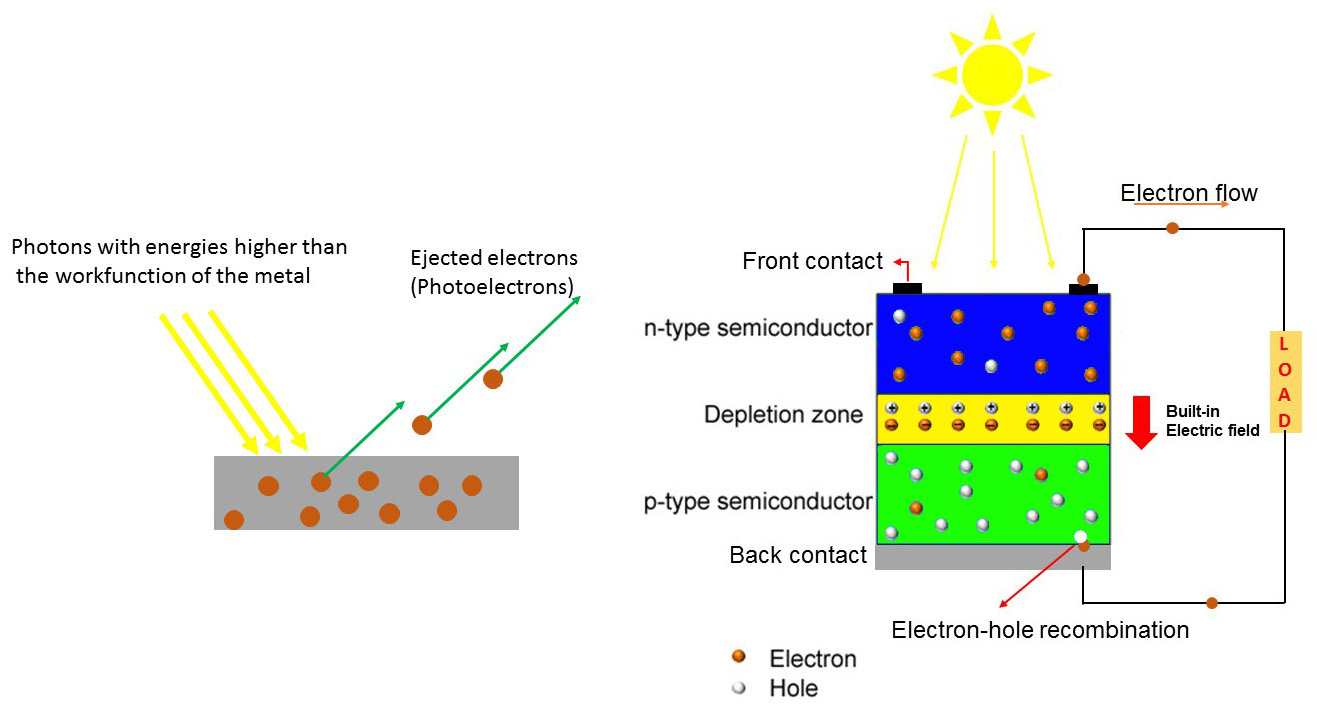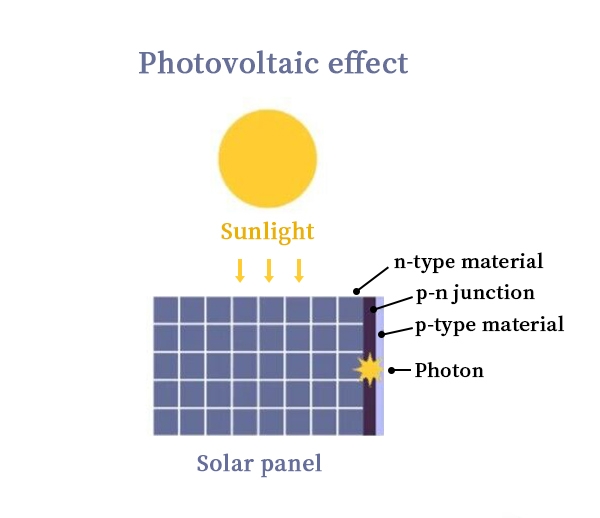Let’s start with a question—have you ever wondered how sunlight transforms into the electricity that powers your home? If you’ve marveled at solar panels glinting on rooftops or vast solar farms spread across deserts, you’re not alone. At the heart of this magical-seeming process is something called the photovoltaic effect.
Now, before you start picturing scientists in lab coats wielding lasers (cool but not quite accurate), the photovoltaic effect is surprisingly straightforward in concept, though the physics behind it is truly fascinating. This phenomenon is the engine driving solar power, a clean and renewable energy source that’s becoming increasingly vital in combating climate change.

At its core, the photovoltaic effect is the process by which light is converted into electricity at the atomic level. When sunlight strikes a material (usually a semiconductor like silicon), it excites the material’s electrons, giving them enough energy to break free and generate an electric current.
In simpler terms, sunlight acts like a motivational coach, shouting, “Get up and go, electrons!” And the electrons? They oblige, creating a flow of electricity that can power your phone, TV, or even your electric car.
What makes this process so special is that it directly converts light energy into electrical energy without the need for moving parts, fuel combustion, or noise. This is why solar panels are silent and so low-maintenance.
Historical Context
Believe it or not, the photovoltaic effect isn’t some 21st-century invention. It’s been around since 1839, when a young French physicist named Edmond Becquerel discovered it during an experiment involving light and electrolytic cells. Imagine stumbling upon the secret to solar power as a 19-year-old—that’s some impressive science fair project, right?
Fast forward to the early 20th century, and none other than Albert Einstein came along to explain the finer details of how light interacts with electrons, a contribution that earned him a Nobel Prize in 1921. (Yep, Einstein wasn’t just about E=mc²!) His work on the photoelectric effect laid the groundwork for modern solar technology.
Today, the photovoltaic effect forms the backbone of solar cells, enabling humanity to tap into the sun’s immense power—an energy source so vast that just one hour of sunlight could power the entire world for a year. That’s right, one hour!

The Physics Behind the Photovoltaic Effect
Energy from Light
The journey of solar power begins with sunlight, which is composed of tiny packets of energy called photons. Think of photons as little messengers carrying the sun’s energy across the vast expanse of space to Earth. Every photon has a specific energy level determined by its wavelength, with shorter wavelengths (like blue and ultraviolet light) packing more energy than longer ones (like red or infrared light).
When photons strike a surface—like a solar panel—they have one job: transfer their energy to electrons. The efficiency of this energy transfer depends on the material the photon interacts with, which is where semiconductors come into play.
Interaction with Semiconductors
Semiconductors are the unsung heroes of the photovoltaic effect, and silicon is the star of the show. Why silicon? For one, it’s abundant (hello, sand!) and has just the right properties to facilitate the photovoltaic effect.
In a semiconductor, atoms are arranged in a crystal lattice, with electrons sitting snugly in specific energy levels. When a photon hits the silicon, it energizes an electron, kicking it out of its “cozy” spot and into the conduction band—a higher energy state where it’s free to move. This process creates something known as an electron-hole pair:
- The electron is the energized particle that’s now ready to flow.
- The hole is the empty space left behind, which behaves like a positively charged particle and helps maintain the balance of the system.
Electron-Hole Pair Formation
Here’s a fun analogy: imagine you’re at a concert, and someone leaves their seat to rush the stage (the electron breaking free). The empty seat they leave behind (the hole) causes a ripple of people shifting in their chairs to fill the gap. That chain reaction, on a microscopic scale, is critical for generating an electric current.
But here’s the catch—not every photon has enough energy to kickstart this process. If the photon’s energy is too low, it just passes through the material. If it’s too high, the extra energy is wasted as heat. This is why solar cells are designed to optimize their interaction with specific wavelengths of light.
The Role of the P-N Junction
Now, let’s talk about the p-n junction, the beating heart of a solar cell. Silicon in solar cells is specially treated (a process called doping) to create two types of material:
- P-type silicon: Rich in “holes” (positive charges).
- N-type silicon: Loaded with free electrons (negative charges).
When these two types of silicon are placed together, they form a junction where an electric field develops. This electric field acts like a one-way gate, pushing free electrons from the p-side to the n-side while keeping the holes on the opposite side. This separation of charges is what creates the potential difference (or voltage) needed to drive an electric current.
Generation of Current
Finally, let’s connect the dots (literally). When sunlight excites the electrons, the electric field at the p-n junction directs them to flow in one direction through an external circuit. Voilà! You have a steady current of electrons moving, which translates into usable electricity.
This current is then sent to an inverter, where it’s converted from direct current (DC) to alternating current (AC)—the type of electricity that powers our homes and devices.
Summary in Numbers
| Key Factor | Role in Photovoltaic Effect |
|---|---|
| Photon energy (eV) | Excites electrons in the semiconductor. |
| Semiconductor (e.g., silicon) | Provides a structure for electron flow. |
| P-N Junction | Creates an electric field to separate charges. |

Materials and Technology in Photovoltaic Cells
Common Materials Used
When it comes to photovoltaic cells, not all materials are created equal. The most common material by far is silicon, thanks to its abundance, durability, and unique electronic properties. But silicon isn’t the only player in the game.
Here’s a breakdown of the materials most often used in photovoltaic cells:
- Monocrystalline Silicon:
- Made from a single, continuous crystal structure.
- Offers the highest efficiency (around 20-22%) but is also the most expensive.
- Recognizable by its uniform dark appearance.
- Polycrystalline Silicon:
- Composed of multiple silicon crystals.
- Slightly less efficient (15-18%) but more affordable to produce.
- Has a bluish, fragmented look.
- Thin-Film Materials:
- Includes materials like cadmium telluride (CdTe) and copper indium gallium selenide (CIGS).
- Lightweight and flexible, making them ideal for unconventional applications (think curved surfaces or portable devices).
- Less efficient (~10-12%) but cheaper to manufacture.
- Perovskite Materials:
- The rising star in solar research! These materials promise high efficiency, low production costs, and easy scalability.
- Still in experimental stages but could disrupt the solar industry in the coming decades.
Types of Solar Cells
Understanding the types of solar cells helps highlight how innovations in materials lead to a variety of designs, each with its strengths and weaknesses:
| Type of Solar Cell | Efficiency | Advantages | Challenges |
|---|---|---|---|
| Monocrystalline | 20-22% | High efficiency, long lifespan | Expensive to produce |
| Polycrystalline | 15-18% | Affordable, widely available | Slightly lower efficiency |
| Thin-Film | 10-12% | Flexible, lightweight | Lower efficiency, shorter lifespan |
| Perovskite (experimental) | ~25% (potential) | Low cost, easy to produce | Stability issues, degradation |
Advances in Technology
The solar industry has come a long way from early photovoltaic cells that barely converted 6% of sunlight into electricity. Today, technological breakthroughs are pushing the boundaries of what’s possible:
- Tandem Solar Cells:
- Stack multiple layers of different materials to capture a broader spectrum of sunlight.
- Can achieve efficiencies of over 30% in lab settings.
- Bifacial Solar Panels:
- Capture sunlight on both sides of the panel, increasing energy output by up to 30%.
- Often used in solar farms where reflected sunlight from the ground is significant.
- Quantum Dot Solar Cells:
- Utilize tiny nanoparticles to improve light absorption and energy conversion.
- Still in development but shows promise for higher efficiency at lower costs.
- Concentrated Solar Power (CSP):
- Uses mirrors or lenses to focus sunlight onto small, high-efficiency solar cells.
- Ideal for large-scale solar farms.
The Role of Innovation
These advancements aren’t just about improving efficiency—they’re also about making solar technology more versatile, durable, and cost-effective. Imagine solar panels that are as thin as wallpaper or as flexible as a sheet of plastic. That’s the future we’re heading toward, and it’s powered by the same photovoltaic effect we’ve been exploring.
Fun Fact:
Did you know that the first silicon solar cell, created in 1954 by Bell Labs, had an efficiency of just 6%? Today’s commercial solar panels are over three times as efficient, with some experimental models approaching the 40% mark. That’s like upgrading from a horse-drawn carriage to a Tesla!

Applications of the Photovoltaic Effect
The photovoltaic effect isn’t just powering solar panels on rooftops—it’s revolutionizing industries, transforming transportation, and even reaching outer space. From reducing energy bills to driving the renewable energy revolution, here’s how the photovoltaic effect is applied in the real world.
Solar Power Systems
The most well-known application of the photovoltaic effect is, of course, solar power systems. These systems harness sunlight to generate electricity for homes, businesses, and even entire communities. They come in two primary forms:
- Residential Solar Panels
- Installed on rooftops or in backyards.
- Help homeowners save on electricity bills while reducing carbon footprints.
- Typically generate 5-20 kilowatts of power, depending on the system size.
- Utility-Scale Solar Farms
- Massive fields of solar panels designed to supply electricity to thousands of homes.
- Often combined with battery storage to provide power during cloudy days or nighttime.
- Example: The Bhadla Solar Park in India, the largest in the world, with a capacity of over 2,200 megawatts!
- Off-Grid Systems
- Ideal for remote areas without access to conventional electricity grids.
- Used in cabins, boats, and even rural villages to power essential devices.
Emerging Technologies in Solar Power
Solar technology isn’t standing still. New applications of the photovoltaic effect are pushing boundaries and bringing energy solutions to unexpected places:
- Bifacial Panels:
- These innovative panels capture sunlight on both sides, increasing energy output. Perfect for areas where sunlight reflects off surfaces like snow or sand.
- Building-Integrated Photovoltaics (BIPV):
- Imagine solar panels that double as windows, roof tiles, or walls. BIPV systems integrate seamlessly into building designs while generating power.
- Floating Solar Farms:
- Panels installed on water bodies, such as reservoirs and lakes, to save land and reduce water evaporation.
- Example: China’s massive floating solar farm on a former coal mine.
- Solar Roads and Paths:
- Solar panels embedded into roads and bike paths. While still experimental, they offer a glimpse into how infrastructure might generate its own power in the future.
Beyond Solar Panels: Unique Applications
The photovoltaic effect isn’t limited to static solar panels; it’s also finding applications in dynamic and unexpected ways:
- Satellites and Spacecraft
- Every satellite you see orbiting Earth (think GPS, weather satellites, and the International Space Station) relies on solar power. Space agencies use highly efficient solar cells to ensure a constant power supply far from Earth.
- Transportation
- Solar-powered cars, buses, and boats are slowly making their way into the mainstream. For example:
- Solar Impulse 2: A solar-powered plane that flew around the world without using fuel.
- Solar-powered electric vehicle (EV) charging stations are popping up globally.
- Solar-powered cars, buses, and boats are slowly making their way into the mainstream. For example:
- Wearable Technology
- Tiny solar cells are now embedded in smartwatches, fitness trackers, and even backpacks, allowing them to charge on the go.
- Agriculture
- Agrivoltaics combines farming and solar energy by installing solar panels above crops. This dual-use approach generates electricity while protecting plants from extreme weather.
- Portable and Emergency Power
- Foldable solar panels for camping or emergency kits are a simple yet effective way to use the photovoltaic effect.
Case Study: The Rise of Solar-Powered Cities
Cities worldwide are embracing the photovoltaic effect to transition to renewable energy. For instance:
- Freiburg, Germany: Known as the “Solar City,” Freiburg boasts solar panels on nearly every building, producing more energy than the city consumes.
- San Diego, USA: The city plans to run entirely on renewable energy by 2035, with a significant portion coming from photovoltaic systems.
These cities demonstrate how the photovoltaic effect can be scaled up to power entire communities sustainably.
Fun Fact:
In 2019, solar energy officially became the cheapest source of electricity in history. According to the International Energy Agency, utility-scale solar power costs less than coal or natural gas in many regions of the world.
From rooftops to roads, outer space to wearable tech, the applications of the photovoltaic effect are as diverse as they are transformative. Solar technology is no longer just about reducing electricity bills—it’s about creating a sustainable future powered by the sun.